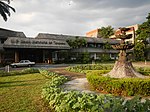U.P. Campus, Quezon City
Barangays of Metro ManilaBarangays of Quezon CityQuezon CityUniversity of the Philippines DilimanUse mdy dates from May 2022

U.P. Campus is a barangay in Quezon City, Philippines. As its name suggests, a large part of the barangay is occupied by the main Diliman campus of the University of the Philippines (UP). UP Diliman, the university campus itself, covers seven other barangays in Quezon City, namely Krus na Ligas, San Vicente, Botocan, Culiat, Old Capitol Site, Pansol, and Vasra.
Excerpt from the Wikipedia article U.P. Campus, Quezon City (License: CC BY-SA 3.0, Authors, Images).U.P. Campus, Quezon City
Ylanan Street, Quezon City Diliman (4th District)
Geographical coordinates (GPS) Address Nearby Places Show on map
Geographical coordinates (GPS)
| Latitude | Longitude |
|---|---|
| N 14.6549 ° | E 121.0633 ° |
Address
University of the Philippines Diliman (UP Diliman)
Ylanan Street
1100 Quezon City, Diliman (4th District)
Philippines
Open on Google Maps





